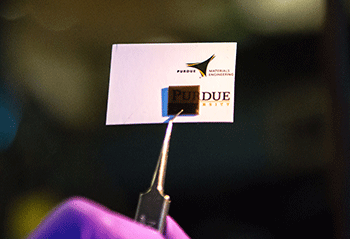Electricity sensor harnesses a shark’s secret weapon
This new material changes in response to tiny electric fields at sea

Sharks have an uncanny ability to sense tiny electrical fields. It helps them home in on prey. A new electronic sensor now mimics that ability — and works in saltwater.
ShaneGross/iStockphoto
Sharks have a secret weapon in their snouts that helps them hunt prey. It’s an organ that can sense faint electrical signals given off by other, delicious creatures. Now, engineers in Indiana have made a new material for electronics that mimics the shark’s sensor. It even works in salt water, which is usually a harsh environment for electronics. (Drop your smartphone in the ocean, for instance, and that’s the end of the phone.)
The new device may be useful in ways from studying marine life to building new tools for submarines. It’s made from a substance called samarium nickelate, or SNO. And it can detect some of the weakest electric fields found in the sea.
Many marine animals, from tiny clams to big fish, produce electric signals. Sharks and other ocean predators, including skates and rays, sense those electric fields. They do it using organs known as ampullae (AM-puh-lay) of Lorenzini. Scientists call such tissues electroreceptors because they detect electric fields.
The ampullae look like a line of small holes, or pores, near the mouth on a shark’s snout. Those pores lead to short channels filled with a jelly-like substance. At the other end of the channels, behind the jelly, are special sensing cells.
When a fish swims nearby that gives off an electric field, those cells send signals to the shark’s brain: “Dinner!”
The new SNO detects electricity, too. It’s an example of a quantum material. That means it has electronic properties — ones that scientists can’t fully explain. (These properties, called quantum effects, are due to the weird behaviors of atoms at the smallest scales.) Even though scientists don’t understand exactly why a quantum material does what it does, they still can study its effects.
The researchers described their new type of SNO in the January 2018 Nature.
This doping is a good thing
Shriram Ramanathan works at Purdue University in West Lafayette, Ind. The materials engineer led a team that designed the new sensor. SNOs have been Ramanathan’s focus for eight years. Their appeal? They act differently in different situations. At room temperature or cooler, for instance, an SNO will let some electric charge pass through. That makes it a semiconductor. But at a toasty 130° Celsius (266° Fahrenheit), it becomes a true conductor. That means it freely allows charge to flow through it.
In 2014, Ramanathan and his team found another way to change an SNO. They added protons, which are particles with positive charges. Adding extra molecules or protons to a material is called “doping.” It made the SNO an insulator at room temperature. That means it does not let electric charges pass through. Importantly, it showed the scientists how to adjust the properties of the material. They could “tune” the material to be more or less conductive at temps below 130 °C by simply adding or removing protons.
By tuning it in this way, the researchers can make their SNO more sharklike. In the last few years, for instance, scientists have discovered that the jelly in those shark pores is good at conducting protons. They suspect those protons make the shark more sensitive to electric fields. They do the same thing for the new SNO: Added protons make it super-sensitive. The doped SNO also works in salt water — another similarity to sharks.

When the new SNO senses an electric field, its resistivity goes up. That means it blocks electric charges from passing through. At the same time, it becomes transparent. So an SNO in the water can reveal electric fields both by how it conducts electricity and by its appearance.
Unlike a shark, the new material is dark and shiny. In their latest study, the researchers worked with a slice no bigger than the nail on your pinkie. They tested its sensing power using salt water samples in the lab. The SNO detected fields as weak as 4.5 microvolts, which is about the strength of a field given off by a sea snail. They soon plan to take it to sea, for more testing.
Smart sensing
Gustau Catalán did not work on the new study. He’s a physicist at the Catalan Institute of Nanoscience and Nanotechnology in Barcelona, Spain. Catalán is an expert on perovskite nickelates, the family of materials that includes SNO.
He’s encouraged by the development of the sensor. He sees its use in the ocean as a “natural and promising” application. That’s because protons make SNOs better at sensing, and protons are plentiful in the sea. “A proton is just a hydrogen atom minus an electron,” he says, and there’s plenty of hydrogen in water. “That’s what the ‘H’ stands for in ‘H2O.’”
Submarines could use SNO-based sensors to find other vessels or nearby fish. The sensors might be used to track the movements of animals, or to make other measurements in water.
Getting SNO to sense electrical fields was challenging, Ramanathan says, and took three steps. The first was creating the material. (He estimates it took two or three years to get the recipe right.) The second was discovering that doping SNO with protons improved the material’s properties. (That work took another three to four years.) Finally, his team had to figure out how to tune the material’s conductivity for particular uses. That meant finding the right way to add protons to the SNO. While testing this doped SNO, they discovered it works in salt water.
Ramanathan still isn’t done. His ultimate goal is to use SNOs to create devices that can learn in the same way the brain learns, by remembering and forgetting things. Doping SNOs, he says, is like building in memory about how to respond to something in the environment.
He envisions SNO-based materials, such as smart windows, that can remember when to darken or lighten a room based on the light coming in from outside.
Indeed, he observes, “Sensing is a form of intelligence.”
This is one in a series presenting news on technology and innovation, made possible with generous support from the Lemelson Foundation.







